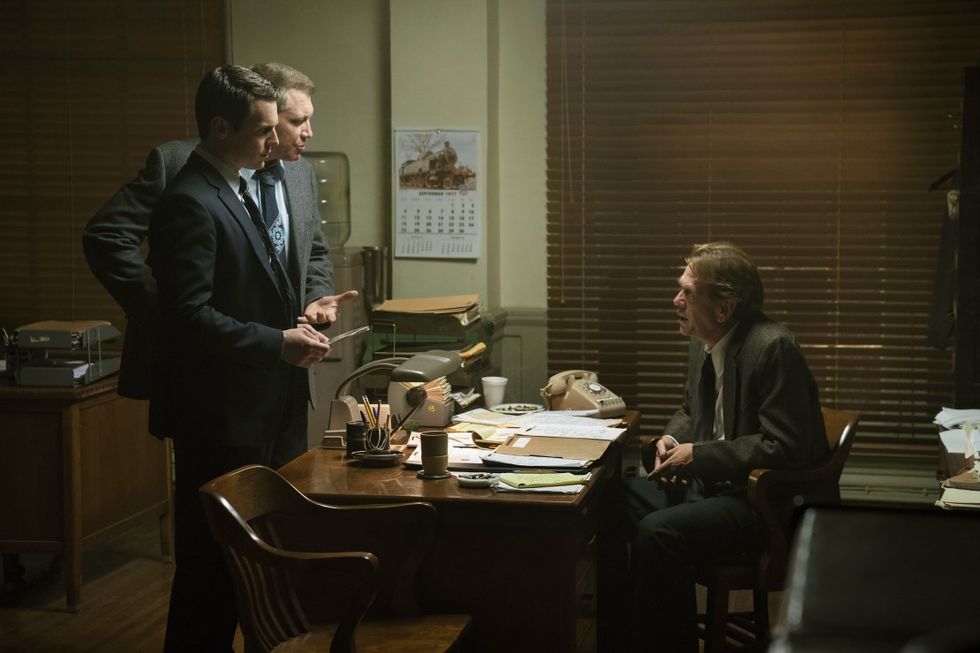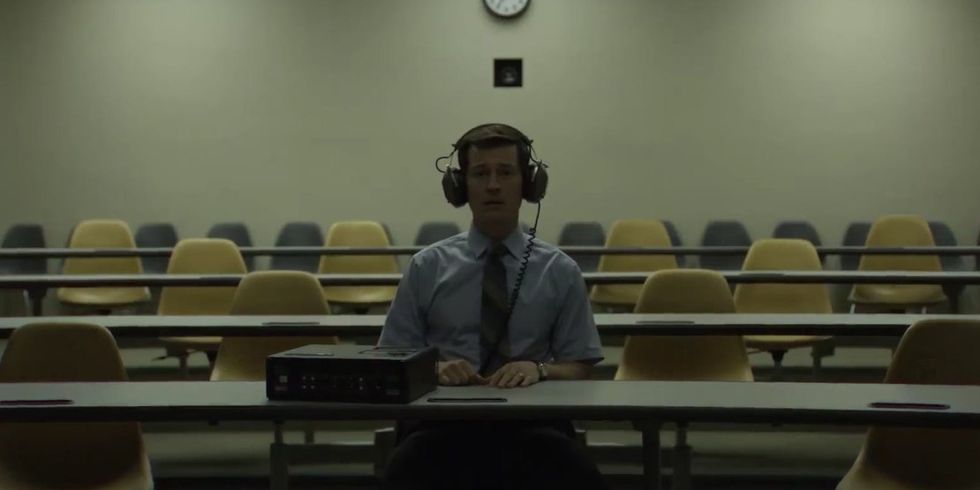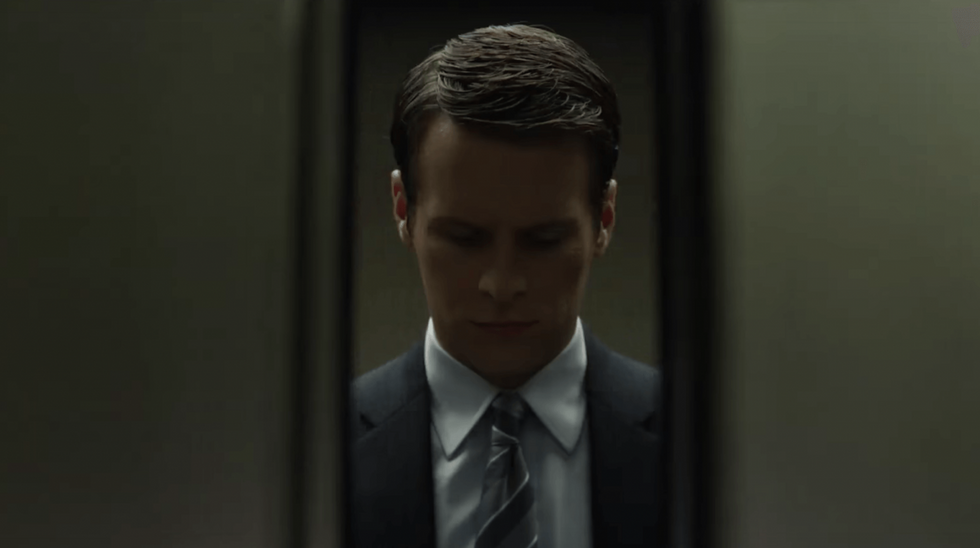Why David Fincher's 'Mindhunter' DP Believes 'There Are No Rules' in Lighting
'Mindhunter' DP Erik Messerschmidt shot the darkly intimate show with custom-made RED Xenomorphs.

When it comes to cinematography, every filmmaker, every movie or show, and every shot is different. While there may be a “textbook” way to approach a scene, there is no “correct” way. Even so, patterns and styles always emerge, and few filmmakers have developed a look as distinctive as David Fincher's. While Fincher is best known for his mysterious and gritty films, ranging from Fight Club to The Social Network, he’s recently ventured into the realm of streaming television, where he has produced and directed the critically-acclaimed House of Cards, and now seeks to expand on that success with the recently-released Mindhunter for Netflix.
Mindhunter tells the story of a pair of FBI agents, played by Jonathan Groff and Holt McCallany, as their work in the Elite Serial Crime Unit leads them down a dark path where they interrogate and explore the mindsets of serial killers and rapists. It’s another psychologically tense world from the mind of Fincher, and a significant part of what brings this world to life is the work of cinematographer Erik Messerschmidt, who keeps audiences grounded and in the moment.
"The camera work should never draw the audience out of the story."
Messerschmidt, a longtime gaffer in the industry, built up years of knowledge while working alongside some of the best DPs in Hollywood, and his unique background allowed him to creatively solve problems and accentuate story with his camerawork. No Film School recently sat down with Messerschmidt to talk about his career and Mindhunter, including his decision to come up through the lighting department, mastering crew-management skills, and how to incorporate natural lighting into your shots.
No Film School: As a long-time gaffer, did you always want to become a cinematographer?
Erik Messerschmidt: I always saw myself ending up as a DP. When I was at Emerson College, I did a lot of shooting, just like everybody does in film school, but I also worked at a lighting rental house in Boston. I worked for the owner as an electrician, and later as his best boy, doing some commercials and small movie stuff, and because he was a union shop, I got into the IA really young.
By the time I moved to LA I already had that grip/electric background, and I’m not independently wealthy, so I had to find a job. Working in the electrical department was the obvious thing. It wound up being a really great way to get immediate access to the film set, and there were always small projects that I was shooting on the side while I was working as an electrician or gaffer.
"Working as a gaffer on bigger films, I learned to master one of the huge parts of the job, which is management."
NFS: Do you feel like you got any distinct advantages by working in lighting as opposed to the camera department?
Messerschmidt:I think everybody has to find their own path. Out of college, I thought I would just go to Los Angeles and do something in the camera department, but I quickly found that I didn’t really feel qualified. I really wanted to learn—to watch people work, to see the methods. When you watch, you learn that everybody has different techniques and everybody has different solutions to problems. Seeing that was a huge advantage because I had the great opportunity as a gaffer to work intimately with a lot of really fantastic DPs who also became my mentors.
I think when you work as a focus puller or as a 2nd AC or an operator, you don’t necessarily participate in those solutions. You may witness it, but you’re focused on your own job, and you may not be fully aware of how those solutions come to fruition.
And the other side of it, especially working as a gaffer on bigger films, I learned to master one of the huge parts of the job, which is management: leadership, dealing with budgets and schedules, communicating with the 1st AD and production manager, and all that stuff that DPs have to do but camera operators and assistants don’t.

Messerschmidt: I think that it really helped; it’s a huge part of being a DP. You have to maintain the crew’s interest in the project while simultaneously holding people accountable. You have to empower people. You want everyone to bring something to the project, and you want to give them the opportunity to express themselves. That’s why we all got into the movie business: we’re all interested in expressing our own creativity and participating in the process. It's very much about collaboration. I think working as a gaffer made me appreciate that in a pretty unique way because as a gaffer I wanted to participate, and I was able to work with DPs who empowered me and liked that about me. Now that I’m shooting, I try to do that with my crew. I want people to feel like they are participating in the project.
NFS: You mentioned working with a lot of really big DPs, and that list includes Jeff Cronenweth on Gone Girl. How integral was that experience with Jeff for your work on Mindhunter?
Messerschmidt: That was hugely important and informative. We had done commercials before, but Jeff and I really clicked on Gone Girl, and we were pretty succinct in terms of our aesthetic and approach to solving problems. Now, Jeff and I have become very close and he has been an incredible mentor to me and helped me in my transition to shooting, but Gone Girl served as my introduction to David Fincher’s filmmaking methods.
"I think it’s our responsibility as DPs is to learn what it is that drives a director visually and support it."
NFS: How did you wind up getting onto Mindhunter?
Messerschmidt: I have a stills background, having worked in the fine art world for a little while, and David and I had done some publicity work for Gone Girl, which was a nice little opportunity to be more involved with him directly. We got along well, so when they were looking for a DP on Mindhunter, they called me to come in. I was honored to get the offer, and I’d like to think that David saw that there was some shared sensibility and shared values in terms of how things should look and how we should approach them visually. We had similar language in terms of our cinematic vocabulary, so it was easy.

Messerschmidt: The hope is that every director brings an aesthetic voice to a project. As a cinematographer, you don’t necessarily want to be wholly responsible for the look. You want to have somebody that is driving the boat because the look has to be holistic. It has to come from one place to be successful. If the DP and the production designer and the director are all approaching the project from different vantage points it’s likely it won’t be cohesive. I think it’s our responsibility as DPs is to learn what it is that drives a director visually and support it.
And I actually felt like I had a lot of creative freedom. There was a lot of room to bring something to the table and suggest different ways I wanted to do things or find tools I wanted to use. David was very supportive, but it all fits within a framework of something that he put together.
NFS: What were some of the defining traits that you guys tried to bring to Mindhunter?
Messerschmidt: Probably the best way to describe it would be to say we wanted a surrealist naturalism to it. I really wanted to work with practicals as much as possible, particularly in the night interiors—be willing to let things go dark or be in silhouette. We wanted the light sources to be motivated—if a light is in a frame, it’s lighting a scene. We also wanted to avoid a lot of relighting between setups and not necessarily light for shape or contrast. If, for example, someone is sitting against a window and they’re backlit, then you turn around to the person they’re talking to, and the other person should be front lit, and that’s okay. We didn’t want to cheat for “good contrast” or “good aesthetic.” Let the room light the actors. We rated the camera a little lower than people are typically working in the digital world. We shot at 640 ASA and did most of the show at a 2.5, so when we were doing lighting, it gave us a little bit of shape and bite. The Lite Mat turned out to be a hugely helpful tool for us, especially on locations, and we used a lot of HMI’s, incandescents and a lot of the L-7 and L-5 Sky Panels too.
"We didn’t want to cheat for 'good contrast' or 'good aesthetic.' Let the room light the actors."
In terms of camera, we worked really hard to keep the camera on the dolly, keep things simple, and keep the camerawork hidden. We weren’t doing a bunch of fancy camera movement. We were really trying to let the performance play and let the actors have the space. There’s a lot of focus on composition, and that’s obviously something that comes from David’s aesthetic, but we were trying very hard not to bring a lot of attention to our work. My hope would be that people maybe notice my work on the second or third viewing. The camera work should never draw the audience out of the story. It should support the story and what we’re all trying to bring to the audience.

Messerschmidt: When it comes to practical lighting, we live in a world now where technology allows us to look at the image on the monitor in real-time and make that aesthetic choice immediately. We tried to be thoughtful about where we put the light in the frame, and when it comes to practicals you just put the light where it looks good. Experiment. Try things out.
When I first started, I read all the books, and I assumed that I had to use the prescribed method to make things look good. The reality is that there are no rules. Certain guidelines lead to certain results, but I think it’s important for young filmmakers to find their own voice and take chances. If it supports the story, be willing to go dark. We did a lot of stuff that was flat or front lit because that’s what the staging of the scene offered, and that’s okay. It can still be beautiful. There are some unbelievable examples in cinema where people have done really spectacular work in front light. Just make thoughtful decisions about what looks good and what doesn’t, and stand by your decisions.
NFS: When you’re establishing a certain color palette, like Mindhunter’s green/yellow tone, how do you approach lighting every scene?
Messerschmidt: That very specific color palette certainly comes from David, and on my end, it was conscious decisions like cool-white fluorescents, and sodium vapor night exteriors, and incandescent shot under 4,000 Kelvin color balance on the camera. But a lot of that look comes from Steve Arnold, our production designer, and Jennifer Starzyk, our costume designer, who were incredible. I think I’m the last link in the chain right before color correction. We had spectacular sets that were very consistent and thoughtful, so I think a lot of the palette really came from that.

Messerschmidt: The interrogation room scenes are where the action happens in the show. All of the drama comes from these long, very elaborate dialogue scenes where the actors really have a lot of space and a lot of room to explore things, so our job kind of became about getting coverage. We wanted to give the editors room to build tension through the edit. We shot close-ups, tight eyelines, wide eyelines, low-shots, profiles, wide overs, and multiple master shots, so that the editors could play with the rhythm of the scene and experiment. That was a huge part of the time we spent on the series.
And in terms of lighting, we tried to really approach it in the same way. Most of the interrogation rooms were sets that were built on a stage, and Steve and I worked together in making choices ahead of time that would work for the staging of the scene so that we could get some shape and texture in the room and make it mysterious when it needs to be mysterious.
"All of the ancillary after-market sort of stuff that camera assistants attach to the outside of the camera was built into the camera."
NFS: You guys used a custom-made camera, right?
Messerschmidt: Yeah, the RED Xenomorph. We had three of them, and they performed flawlessly. The camera had integrated wireless video, built-in Zaxcom Prime Code and a built-in wireless control unit for the RT motion focus-control and iris-control. All of the ancillary after-market sort of stuff that camera assistants attach to the outside of the camera was built into the camera. It was fantastic because it resulted in a situation where it was literally putting a battery on the back of the camera and a lens on the front, and we could go shoot. The goal was, and it’s absolutely driven by Fincher, to get back to the simplicity of the days when you would just slap the magazine on the top of the camera and the lens on the front and a mechanical follow-focus, and you could shoot. There weren’t cables, and batteries, and breakout boxes stuck to the side of the camera, so when you have to put the camera against a wall, or you’ve got to put the camera in a car we didn’t have to spend huge amounts of time relocating cables and unplugging boxes and all that.
NFS: What lenses did you use for the most part?
Messerschmidt: We shot about 98% of the show on Leica Summilux, and we lived primarily on the 29mm and the 40mm. It was really nice to work with some very specific focal length. That decision really helped maintain a consistent visual language. There were a couple of scenes where we needed longer lenses, so I used an Ultra Prime 180 at a 2. And I used the 75, 400, and 24-180 Fujinon Premiere Zooms a couple of times because they were good a resolution match to the Leicas.

Messerschmidt: I think the hardest thing for cinematographers to pull off is the day exterior, and on Mindhunter it became even harder because a lot of the scenes are very long so we would shoot them over multiple days. For example, there’s an 8-page interrogation scene outside of a house in episode 3, and we were shooting in Western Pennsylvania in the summertime, so every five minutes it could shift between raining, cloudy, humid, or even lightning. The location was beautiful but really restrictive with lots of trees and low power lines, so bringing in lots of grip equipment to control sunlight wasn’t necessarily in the cards. Fortunately, the actors were very patient with me and understood what was going on, and I used our resources, like some condors, to do our best.
And then we shot another sequence at a trash dump in episode 4 where the set was such that we couldn’t bring the dolly in. Instead, we shot most of it from two Chapman hydrascopes, which are really great tools. I was able to shoot almost all the coverage off the cranes and maintain our very rigid, proscenium method throughout the scene without having to go in there with a couple of handheld cameras and change the style of the show just to get the scene done.











